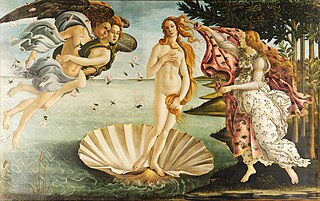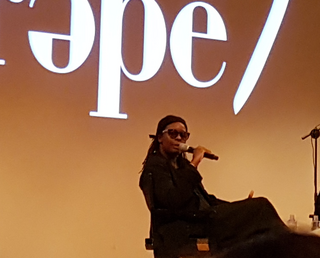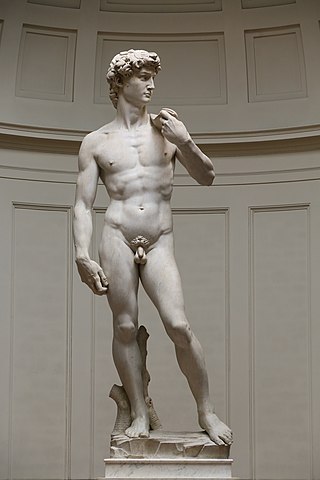Harmonia Rosales | |
|---|---|
 Rosales in 2021 | |
| Born | February 6, 1984 Chicago, Illinois, U.S. |
| Known for | The Creation of God (2017 painting) |
| Style | Painting |
Harmonia Rosales (born 1984) is an American artist from Chicago. [1] [2] [3]
Harmonia Rosales | |
|---|---|
 Rosales in 2021 | |
| Born | February 6, 1984 Chicago, Illinois, U.S. |
| Known for | The Creation of God (2017 painting) |
| Style | Painting |
Harmonia Rosales (born 1984) is an American artist from Chicago. [1] [2] [3]
Rosales works mostly as a classical painter depicting women and people of color assuming roles of power and beauty in exquisite imaginings of ancient myths, Afro-Cuban culture, and Renaissance paintings. Her artistic style are detailed renderings involving oil paint, raw linens, gold leaf, and wood panels. Since 2017, her work has used iron oxide to portray not only African soil but the decay in African history in America, a choice she intended to amplify the question “Why? Why have we accepted Eurocentric perceptions of beauty and historical narratives for so long?”
In 2017, Rosales participated in the Museum of Science and Industry's Black Creativity Juried Art Exhibition. The painting was of her daughter and included all the elements of being overexposed and categorized at a young age. This award encouraged Rosales to move away from portraits and create a strong body of work. Due to Rosales' painting techniques, she is only able to produce 9-10 paintings a year.


In 2017, Rosales posted an image, The Creation of God, on social media, of her first completed work for her solo exhibition Black Imaginary To Counter Hegemony. The painting is an oil-on-canvas piece that took two months to craft. In this painting, Rosales recreates Michelangelo’s Creazione di Adamo (The Creation of Adam) by displaying both God and Adam as Black women. The Creation of Adam shows Jehovah’s finger and the elegant, naked body of the first man. In contrast, the painting created by Rosales shows God as a black woman and creates the illusion of the heavens as a womb from which she is birthing Eve in an act of strength and empowerment. This image was created to show that White subjects are the standard in classic art while challenging the viewer to consider why that practice is commonly accepted.

In 2017 Rosales was picked up by Simard-Bilodeau Contemporary, an art gallery based in LA and was given her first solo exhibition. Included in the show was Creation of God. One of her many works included The Birth of Oshun , an oil-on-canvas painting, which reimagines Sandro Botticelli’s work, Birth of Venus, by placing Oshun, the Yoruba goddess of fertility, sensuality, and prosperity, in a sea shell surrounded by black angels, in contrast to Botticelli’s painting where a White Venus, the goddess of love, beauty, and fertility, is in a sea shell surrounded by white angels. [4] In this painting, Oshun has vitiligo that is made of gold patches that have roots in traditional Nigerian storytelling traditions. [5] The painting is meant to challenge the perceptions of beauty because as she says, “traditionally, we see Venus as this beautiful woman with flowing hair. My hair never flowed, so I’m wondering why this is supposed to be a painting of the most beautiful woman in the world.” This painting works to show the beauty in imperfection, such as the patches of vitiligo, a skin condition. [6] She also says that she created this work with her daughter in mind in order to show her daughter that black women, and their natural hair, are beautiful.
Rosales was born on February 6, 1984, in Chicago, Illinois, to Cuban-born Giraldo Rosales and Jamaican-Jewish illustrator Melodye Benson Rosales. She was raised in the Santería religious tradition.
Having both parents’ ancestries rooted along the West African coast, Rosales meticulously entwines her adversities and cultural background to challenge the viewers' ideas about identity and empowerment in her art.

Alessandro di Mariano di Vanni Filipepi, better known as Sandro Botticelli or simply Botticelli, was an Italian painter of the Early Renaissance. Botticelli's posthumous reputation suffered until the late 19th century, when he was rediscovered by the Pre-Raphaelites who stimulated a reappraisal of his work. Since then, his paintings have been seen to represent the linear grace of late Italian Gothic and some Early Renaissance painting, even though they date from the latter half of the Italian Renaissance period.

The Birth of Venus is a painting by the Italian artist Sandro Botticelli, probably executed in the mid 1480s. It depicts the goddess Venus arriving at the shore after her birth, when she had emerged from the sea fully-grown. The painting is in the Uffizi Gallery in Florence, Italy.

Oshun is an orisha, a spirit, a deity, or a goddess that reflects one of the manifestations of the Yorùbá Supreme Being in the Ifá oral tradition and Yoruba-based religions of West Africa. She is one of the most popular and venerated Orishas. Oshun is an important river deity among the Yorùbá people. She is the goddess of divinity, femininity, fertility, beauty, and love. She is connected to destiny and divination.

Zipporah, or Tzipora, is mentioned in the Book of Exodus as the wife of Moses, and the daughter of Reuel/Jethro, the priest and prince of Midian.

Renee Cox is a Jamaican-American artist, photographer, lecturer, political activist and curator. Her work is considered part of the feminist art movement in the United States. Among the best known of her provocative works are Queen Nanny of the Maroons, Raje and Yo Mama's Last Supper, which exemplify her Black Feminist politics. In addition, her work has provoked conversations at the intersections of cultural work, activism, gender, and African Studies. As a specialist in film and digital portraiture, Cox uses light, form, digital technology, and her own signature style to capture the identities and beauty within her subjects and herself.

Portrait of Simonetta Vespucci is an oil on canvas painting by the Italian Renaissance painter Piero di Cosimo, dating from about 1480 or 1490. It is in the Musée Condé in Chantilly, France.

Pallas and the Centaur is a painting by the Italian Renaissance painter Sandro Botticelli, c. 1482. It is now in the Uffizi Gallery in Florence. It has been proposed as a companion piece to his Primavera, though it is a different shape. The medium used is tempera paints on canvas and its size is 207 x 148 cm. The painting has been retouched in many places, and these retouchings have faded.

Simonetta Vespucci, nicknamed la bella Simonetta, was an Italian noblewoman from Genoa, the wife of Marco Vespucci of Florence and the cousin-in-law of Amerigo Vespucci. She was known as the greatest beauty of her age in Italy, and was allegedly the model for many paintings by Sandro Botticelli, Piero di Cosimo, and other Florentine painters. Some art historians have taken issue with these attributions, which the Victorian critic John Ruskin has been blamed for promulgating.

Venus Anadyomene is one of the iconic representations of the goddess Venus (Aphrodite), made famous in a much-admired painting by Apelles, now lost, but described in Pliny's Natural History, with the anecdote that the great Apelles employed Campaspe, a mistress of Alexander the Great, for his model. According to Athenaeus, the idea of Aphrodite rising from the sea was inspired by the courtesan Phryne, who, during the time of the festivals of the Eleusinia and Poseidonia, often swam nude in the sea. A scallop shell, often found in Venus Anadyomenes, is a symbol of the female vulva.

Museum of Contemporary African Diasporan Arts (MoCADA), is a museum of contemporary art located at 80 Hanson Place in Fort Greene, Brooklyn, New York City. It is the first museum of its kind to be opened in New York.

Mickalene Thomas is a contemporary African-American visual artist best known as a painter of complex works using rhinestones, acrylic, and enamel. Thomas's collage work is inspired from popular art histories and movements, including Impressionism, Cubism, Dada, the Harlem Renaissance, and selected works by the Afro-British painter Chris Ofili. Her work draws from Western art history, pop art, and visual culture to examine ideas around femininity, beauty, race, sexuality, and gender.
Ọbà is the Orisha of the River Oba whose source lies near Igbon where her worship originates. During the wars of the 19th century, her centers of worship moved to the more secure town Ogbomosho. She is traditionally identified as the senior wife of Shango. Oba was tricked by Oya or Oshun into cutting off her ear and trying to feed it to Shango. She is syncretized with Saint Catherine of Siena.

The nude, as a form of visual art that focuses on the unclothed human figure, is an enduring tradition in Western art. It was a preoccupation of Ancient Greek art, and after a semi-dormant period in the Middle Ages returned to a central position with the Renaissance. Unclothed figures often also play a part in other types of art, such as history painting, including allegorical and religious art, portraiture, or the decorative arts. From prehistory to the earliest civilizations, nude female figures were generally understood to be symbols of fertility or well-being.

Portrait of a Young Woman is a painting which is commonly believed to be by the Italian Renaissance painter Sandro Botticelli, executed between 1480 and 1485. Others attribute authorship to Jacopo da Sellaio. The woman is shown in profile but with her bust turned in three-quarter view to reveal a cameo medallion she is wearing around her neck. The medallion in the painting is a copy in reverse of "Nero's Seal", a famous antique carnelian representing Apollo and Marsyas, which belonged to Lorenzo de' Medici.

Venus and Mars is a panel painting of about 1485 by the Italian Renaissance painter Sandro Botticelli. It shows the Roman gods Venus, goddess of love, and Mars, god of war, in an allegory of beauty and valour. The youthful and voluptuous couple recline in a forest setting, surrounded by playful baby satyrs.

The Calumny of Apelles is a panel painting in tempera by the Italian Renaissance painter Sandro Botticelli. Based on the description of a lost ancient painting by Apelles, the work was completed in about 1494–95, and is now in the Uffizi, Florence.

Primavera, is a large panel painting in tempera paint by the Italian Renaissance painter Sandro Botticelli made in the late 1470s or early 1480s. It has been described as "one of the most written about, and most controversial paintings in the world", and also "one of the most popular paintings in Western art".

Trinidad Orisha, also known as Orisha religion and Shango, is a syncretic religion in Trinidad and Tobago and the Caribbean, originally from West Africa. Trinidad Orisha incorporates elements of Spiritual Baptism, and the closeness between Orisha and Spiritual Baptism has led to use of the term "Shango Baptist" to refer to members of either or both religions. Anthropologist James Houk described Trinidad Orisha as an "Afro-American religious complex", incorporating elements mainly of traditional African religion and Yoruba and incorporates some elements of Christianity, Hinduism, Islam, Buddhism, Judaism, Baháʼí, and Amerindian mythologies.
Elizabeth Colomba is a French painter of Martinique heritage known for her paintings of black people in historic settings. Her work has been shown at the Gracie Mansion, the Wallach Art Gallery at Columbia University, the Museum of Contemporary African Diasporan Arts, the Musée d'Orsay, Los Angeles County Museum of Art, and the Metropolitan Museum of Art.
Ndidi Emefiele is a Nigerian contemporary artist and painter. She was born on June 12, 1987 in Abuja, Nigeria and she currently lives in Northampton, UK. Emefiele's works are composed on large canvases and a great use of color and very bold brush strokes. Ndidi Emefiele started her career in Nigeria but later moved to the United Kingdom.